![]()
![]()
![]()
Use LEFT and RIGHT arrow keys to navigate between flashcards;
Use UP and DOWN arrow keys to flip the card;
H to show hint;
A reads text to speech;
10 Cards in this Set
- Front
- Back

|
Palette of King Narmer
Ancient Egypt (Predynastic period), 1st Dynasty, ca. 3000–2920 BCE. (30th century BCE) Slate, Egyptian Museum, Cairo.
- grind eyeliner; fish and chisel (nar and mer); depicts unification of Egypt; Narmer = King Menes?; two crowns of Egypt
1. Pharaoh is always clothed (clothing shows importance) in Egyptian Art and his name(chisel and fish) are shown above him. 2. The Bulls at the top represent a symbol for one of the gods. 3. Originally used to mix make-up on, but this one was not used, more of an offering made to the gods. 4. Overall theme shows the idea of the unification of Egypt, papyrus represents upper Egypt. (It depicts unifying the Upper and Lower Egypt) 5. Insures passage of soul into the afterlife through worship of Horus(falcon). |
|
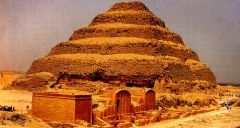
|
Stepped pyramid of King Djoser
Saqqara, Egypt, Dynasty III
2630-2611 BCE (27th century BCE)
* pyramid designed by Imhotep: royal builder for King Djoser, pharaoh's chancellor, high priest of the sun god |
|

|
restored view of the mortuary precinct of King Djoser Saqqara, Egypt, Dynasty III
2630-2611 BCE (27th century BCE)
* pyramid at center, surrounded by large protective limestone wall (barriers here vs. Sumerians) |
|
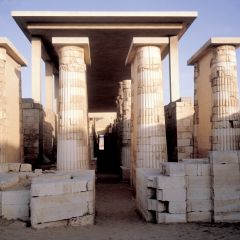
|
columnar entrance corridor to the mortuary precict of Djoser
Saqqara, Egypt, Dynasty III
2630-2611 BCE (27th century BCE)
Columns: on either side of roofed passageway leading to large courtyard to Djoser's pyramid
Impacted later Greek columns |
|
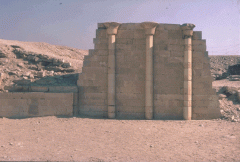
|
facade of the North Palace of the mortuary precinct of Djoser
Saqqara, Egypt, Dynasty III,
2630-2611 BCE (27th century BCE)
capitals: heads that take the form of papyrus blossoms of Lower Egypt column shafts = papyrus stalks columns are engaged: attached to the walls first appearance of columns in architectural history |
|
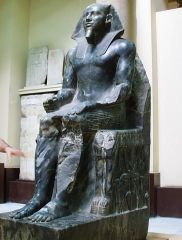
|
Khafre
from Gizeh, Egypt, Dynasty IV,
2520-2494 BCE (26th century BCE)
Diorite, 5' 6" high
Diorite = is a grey to dark-grey intermediate intrusive igneous rock
funerary statues, became homes for ka (god like spirits) diorite was imported = $$$ throne: lion bodies throne's legs: lotus & papyrus plants - Egypt's symbols falcon-god Horus wings = protect pharaoh's head royal false beard ideal flawless body/perfect face (often used in art portraits) regardless of actual age/appearance = godlike nature of king
|
|

|
Ka-Aper,
from his mastaba at Saqqara, Egypt Dynasty V, 2450-2350 (25th century BCE)
Wood, approx 3' 7
increased realism eyes of rock crystal intact - heighten effect stands freely nonroyal Old Kingdom portraits - comfortable life of person
- Significance: -Made of wood, significant because wood rarely survives for thousands of years. - Obesity is a symbol of status of those NOT divine, because it shows a comfort of lifestyle, don't need to do hard labour and lots of food.
|
|
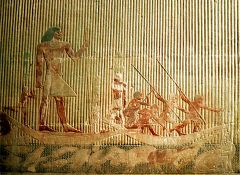
|
Ti watching a hippopotamus hunt
relief in the mastaba of Ti, Saqqara, Egypt Dynasty V 2450-2350 BCE (25th century BCE)
painted limestone, hunting scene
mastaba (egyptian tomb): deceased not represented exclusively in freestanding statuary. Individuals depicted in relief sculpture/mural painting sometimes alone/narrative context
Ti, men & boats move slowly through marshes of papyrus, hunting hippos & birds. top: frightened birds, stalking foxes below: water w/ wavy lines, hippos, fish men: busy w/ spears Ti: big man
conceptual approach: known to be true of subject - most characteristic parts at right angles. expressses feeling for constant & changeless aspect of things
artists use strict canon: system of proportions relief sculptures: grid on wall, various human body parts at specfic points, height of a figure was a fixed number of squares w/ body predetermined size.
|
|
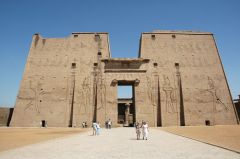
|
Temple of Horus
Edfu, Egypt; ca. 237-47 BCE (3rd century BCE)
, Ptolemaic (Style),
Significance: -Pylon temple built after Alexander in Egypt, indicative of the continuation of the canon of Ancient Egyptian art and its unchanging aspects. - Pylon temples for worshipping Gods, NOT Pharaohs. This is distinctive of pylon temples and newer. |
|
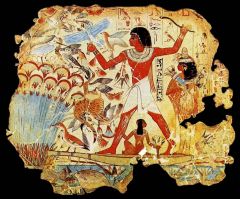
|
Fowling Scene
1400-1350 BCE (15th century BCE), Thebes, Egypt, Fresco on dry plaster (material), Ancient Egypt. New Kingdom. Dynasty XVIII
Significance: The artist scaled down their figures in proportion to their rank, as did Old Kingdom artists. Symbolism: As in Ti's tomb,the Thebes animals show naturalism based on careful observation. |

